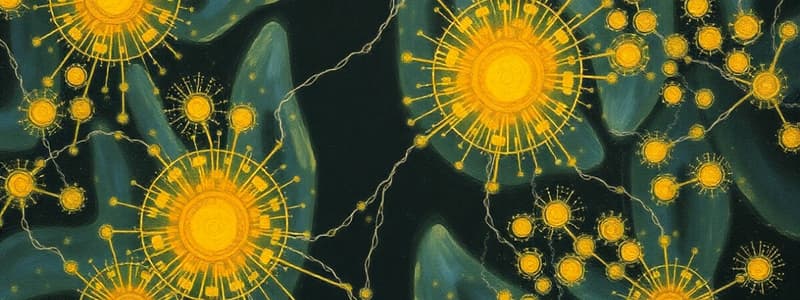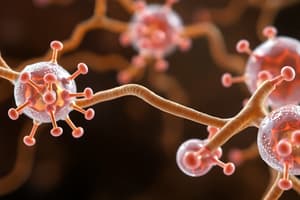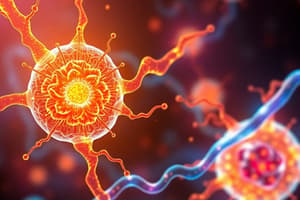Podcast
Questions and Answers
What is the first step in cell signal transduction?
What is the first step in cell signal transduction?
- Response
- Amplification
- Reception (correct)
- Transduction
Which of the following is a characteristic of signal transduction?
Which of the following is a characteristic of signal transduction?
- Deamplification
- Low sensitivity
- Desensitization (correct)
- Low specificity
A molecule that binds to a receptor is called a/an:
A molecule that binds to a receptor is called a/an:
- Effector
- Second messenger
- Enzyme
- Ligand (correct)
Which type of biochemical signal targets distant cells via the bloodstream?
Which type of biochemical signal targets distant cells via the bloodstream?
Where can cell signaling receptors be located?
Where can cell signaling receptors be located?
Which of the following is NOT a type of cell-surface receptor?
Which of the following is NOT a type of cell-surface receptor?
What is a key difference between ionotropic and metabotropic receptors?
What is a key difference between ionotropic and metabotropic receptors?
Which of the following is a second messenger?
Which of the following is a second messenger?
Second messengers are primarily:
Second messengers are primarily:
What is the function of second messengers?
What is the function of second messengers?
What is the general structure of G-protein coupled receptors (GPCRs)?
What is the general structure of G-protein coupled receptors (GPCRs)?
Approximately what percentage of marketed drugs target GPCRs?
Approximately what percentage of marketed drugs target GPCRs?
What is the role of GTP in G protein activation?
What is the role of GTP in G protein activation?
What is the function of the GTPase enzyme?
What is the function of the GTPase enzyme?
Which of the following is a GPCR-mediated pathway?
Which of the following is a GPCR-mediated pathway?
What enzyme synthesizes cAMP?
What enzyme synthesizes cAMP?
What is the function of cAMP?
What is the function of cAMP?
Which intracellular enzyme is activated by second messengers and can phosphorylate other proteins?
Which intracellular enzyme is activated by second messengers and can phosphorylate other proteins?
What is the process of adding a phosphate group to a protein called?
What is the process of adding a phosphate group to a protein called?
What is the purpose of a hormone/enzyme cascade?
What is the purpose of a hormone/enzyme cascade?
Which of the following is an example of signal termination?
Which of the following is an example of signal termination?
What are GTPase-activator proteins (GAPs)?
What are GTPase-activator proteins (GAPs)?
What is signal desensitization?
What is signal desensitization?
Can signal desensitization be reversed?
Can signal desensitization be reversed?
What are CREBs?
What are CREBs?
What activates CREBs?
What activates CREBs?
What is the function of CREBs?
What is the function of CREBs?
Which of the following is involved in the GPCR phosphatidylinositol PIP2 pathway?
Which of the following is involved in the GPCR phosphatidylinositol PIP2 pathway?
Why is calcium an important ion in cell signaling?
Why is calcium an important ion in cell signaling?
How do cells maintain low intracellular Ca2+ concentrations?
How do cells maintain low intracellular Ca2+ concentrations?
What protein binds to calcium to mediate its intracellular effects?
What protein binds to calcium to mediate its intracellular effects?
What is the function of calmodulin?
What is the function of calmodulin?
Receptor protein kinases differ from GPCRs in that they:
Receptor protein kinases differ from GPCRs in that they:
Gated ion channels are:
Gated ion channels are:
Where are gated ion channels found?
Where are gated ion channels found?
How are gated ion channels activated?
How are gated ion channels activated?
Receptor-mediated endocytosis is relevant for:
Receptor-mediated endocytosis is relevant for:
Intracellular receptors bind to what type of ligands?
Intracellular receptors bind to what type of ligands?
Activation of intracellular receptors triggers what kind of cellular response?
Activation of intracellular receptors triggers what kind of cellular response?
Kinases are enzymes that catalyze:
Kinases are enzymes that catalyze:
Receptor tyrosine kinases (RTKs) are activated by:
Receptor tyrosine kinases (RTKs) are activated by:
An example of a ligand for Receptor Tyrosine Kinase is:
An example of a ligand for Receptor Tyrosine Kinase is:
Ionotropic receptors are also known as:
Ionotropic receptors are also known as:
Which of the following ions is commonly associated with ionotropic receptors?
Which of the following ions is commonly associated with ionotropic receptors?
Intracellular receptors are located in the:
Intracellular receptors are located in the:
An example of a lipophilic ligand that binds to intracellular receptors is:
An example of a lipophilic ligand that binds to intracellular receptors is:
Which type of receptor activation leads to the fastest cellular response?
Which type of receptor activation leads to the fastest cellular response?
Clathrin is essential for:
Clathrin is essential for:
In the cAMP pathway, what enzyme does G protein activate?
In the cAMP pathway, what enzyme does G protein activate?
Diacylglycerol (DAG) is a:
Diacylglycerol (DAG) is a:
Inositol trisphosphate (IP3) primarily functions to:
Inositol trisphosphate (IP3) primarily functions to:
Which of the following is NOT a mechanism by which target cells can become desensitized to a signal molecule?
Which of the following is NOT a mechanism by which target cells can become desensitized to a signal molecule?
Beta-adrenergic receptors are examples of:
Beta-adrenergic receptors are examples of:
The alpha subunit of a G protein activates which enzyme in the cAMP pathway?
The alpha subunit of a G protein activates which enzyme in the cAMP pathway?
CAMP activates:
CAMP activates:
The second messenger diacylglycerol (DAG) activates:
The second messenger diacylglycerol (DAG) activates:
Which of the following statements about G proteins is correct?
Which of the following statements about G proteins is correct?
Termination of the GPCR pathway can involve:
Termination of the GPCR pathway can involve:
Beta-blocker drugs are used to treat:
Beta-blocker drugs are used to treat:
Agonists are molecules that:
Agonists are molecules that:
Flashcards
What is Reception?
What is Reception?
The initial step in cell signaling where a cell detects a signal.
What is signal transduction?
What is signal transduction?
A process where a cell converts one kind of signal or stimulus into another.
What is a ligand?
What is a ligand?
A molecule that binds to a receptor protein.
What is Endocrine signaling?
What is Endocrine signaling?
Signup and view all the flashcards
Cell signaling receptors
Cell signaling receptors
Signup and view all the flashcards
What are Intracellular receptors?
What are Intracellular receptors?
Signup and view all the flashcards
Ionotropic receptors
Ionotropic receptors
Signup and view all the flashcards
What is a second messenger?
What is a second messenger?
Signup and view all the flashcards
Function of second messengers
Function of second messengers
Signup and view all the flashcards
GPCRs structure
GPCRs structure
Signup and view all the flashcards
GTP role in G protein activation
GTP role in G protein activation
Signup and view all the flashcards
GTPase enzyme function
GTPase enzyme function
Signup and view all the flashcards
What is cAMP?
What is cAMP?
Signup and view all the flashcards
What is adenylyl cyclase?
What is adenylyl cyclase?
Signup and view all the flashcards
Function of cAMP
Function of cAMP
Signup and view all the flashcards
What are kinases?
What are kinases?
Signup and view all the flashcards
What is phosphorylation?
What is phosphorylation?
Signup and view all the flashcards
Hormone/Enzyme Cascade
Hormone/Enzyme Cascade
Signup and view all the flashcards
Signal Desensitization
Signal Desensitization
Signup and view all the flashcards
What are CREBs?
What are CREBs?
Signup and view all the flashcards
Study Notes
- Cellular Communication involves a 60-question multiple-choice test
Cell Signal Transduction
- Reception is the first step
- Desensitization is a characteristic
- A ligand is a molecule that binds to a receptor
- Endocrine signals target distant cells via the bloodstream
Cell Signaling Receptors
- Cell signaling receptors can be located on the cell surface and intracellularly
- Intracellular receptors are NOT a type of cell-surface receptor
- Ionotropic receptors are ligand-gated ion channels, this is a key difference between ionotropic and metabotropic receptors
Second Messengers
- cAMP is a second messenger
- Second messengers are primarily hydrophobic, hydrophilic and gases
- Second messengers spread the signal to other parts of the cell
GPCRs
- G-protein coupled receptors (GPCRs) have a general structure of seven transmembrane helical segments
- Approximately 35% of marketed drugs target GPCRs
- GTP exchanges with GDP to activate the G protein in G protein activation
- The GTPase enzyme hydrolyzes GTP to GDP
- The cAMP pathway is a GPCR-mediated pathway
cAMP
- Adenylyl cyclase synthesizes cAMP
- cAMP activates protein kinase A
Enzymes
- Protein kinase, an intracellular enzyme, is activated by second messengers and can phosphorylate other proteins
- Phosphorylation is the process of adding a phosphate group to a protein
Hormone/Enzyme Cascade
- A hormone/enzyme cascade amplifies the signal
Signal Termination
- GTP hydrolysis is an example of signal termination
- GTPase-activator proteins (GAPs) speed up GTP hydrolysis, they inhibit G proteins
- Signal desensitization is a decrease in cellular response to a signal
- Signal desensitization can be reversed only in certain cell types
CREBs
- CREBs are transcription factors
- Protein kinase A activates CREBs
- CREBs regulate gene expression
GPCR Phosphatidylinositol PIP2 Pathway
- DAG is involved in the GPCR phosphatidylinositol PIP2 pathway
Calcium
- Calcium acts as a second messenger in cell signaling
- Cells maintain low intracellular Ca2+ concentrations by using Ca2+ pumps
- Calmodulin is the protein that binds to calcium to mediate its intracellular effects
- Calmodulin regulates calcium-dependent enzymes
Receptor Protein Kinases
- Receptor protein kinases differ from GPCRs in that they have intrinsic kinase activity
Gated Ion Channels
- Gated ion channels are membrane proteins that open to allow ions to pass
- Gated ion channels are found on the plasma membrane
- Ligand binding activates gated ion channels
Receptor-Mediated Endocytosis
- Receptor-mediated endocytosis is relevant for internalizing receptors and their bound ligands
Intracellular Receptors
- Intracellular receptors bind to hydrophobic ligands
- Activation of intracellular receptors triggers alterations in gene expression
Kinases
- Kinases are enzymes that catalyze phosphorylation of proteins
Receptor Tyrosine Kinases RTKs
- Receptor tyrosine kinases (RTKs) are activated by autophosphorylation
- Insulin is an example of a ligand for Receptor Tyrosine Kinase
Ionotropic Receptors
- Ionotropic receptors are also known as ligand-gated ion channels
- Sodium (Na+), Potassium (K+) and Chloride (Cl-) are commonly associated with ionotropic receptors
Lipophilic Ligands
- Steroid hormones are an example of a lipophilic ligand that binds to intracellular receptors
Cellular Response
- Ligand-gated ion channels leads to the fastest cellular response
Clathrin
- Clathrin is essential for receptor mediated endocytosis
cAMP Pathway
- In the cAMP pathway, G protein activates adenylyl cyclase
Intracellular Signaling
- Diacylglycerol (DAG) is a hydrophobic second messenger
- Inositol trisphosphate (IP3) primarily functions to release calcium from intracellular stores
Signal Molecule Desensitization
- Receptor upregulation is NOT a mechanism by which target cells can become desensitized to a signal molecule
Beta-Adrenergic Receptors
- Beta-adrenergic receptors are examples of G protein-coupled receptors
Enzymes
- The alpha subunit of a G protein activates adenylyl cyclase in the cAMP pathway
- cAMP activates Protein kinase A
- The second messenger diacylglycerol (DAG) activates protein kinase C
G Proteins
- G proteins are heterotrimeric proteins consisting of α, β, and γ subunits
GPCR Pathway Termination
- Termination of the GPCR pathway can involve intrinsic GTPase activity of the G protein
Beta-Blocker Drugs
- Beta-blocker drugs are used to treat Tachyarrhythmias/high blood pressure
Agonists
- Agonists are molecules that bind to a receptor and mimic the effects of its natural ligand
Studying That Suits You
Use AI to generate personalized quizzes and flashcards to suit your learning preferences.




